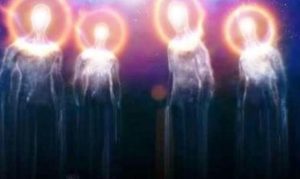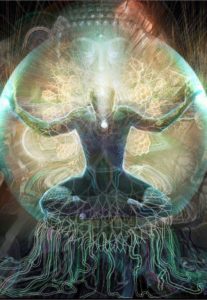Everything the Zennist writes mostly has an immediate bearing on his own experience; yet the Zennist’s realization was only half-realized; he had yet to undergo an experience that would make the analysis of his own Weltanschauung even more profound—a supra-transcendent exposure: his mystical encounter with the kalyana-mitra (or virtuous spiritual friend):
The Zennist: That night during the summer of 1976 at my friend’s dojo, I first thought my friend Bill was kidding when he said there was a deity who wanted to speak with me. Suspecting that he was kidding, I went along with it not expecting anything. Much to my surprise, a blissful presence entered through my heart chakra. It was quite strong as I recall. The next minute, whatever it was, and much to my surprise, it said to me, “Show me what you know.” At that point I went into my one-pointedness of Mind samadhi. At that moment this presence became even stronger. I felt that it was feminine—not male. It was so blissful I could hardly stand up. Bill and Jonathan, my two friends were being affected by it too, but not as much as I. The bliss was almost overwhelming. I thought to myself that if beings were like this all the time who would want to go to work? Evidently, this presence had what seemed to be a personality in addition to being very wise. In this sense I regarded it as likely a kalyanamitra.
I learned later that I could ask it to enter me and leave. This helped me to drive and do other things. The bliss that the kalyana-mitra put out took some time to get used to. Eventually, I didn’t need to ask her to leave. Communication was mainly binary consisting of yes or no…
Looking back in hindsight I think one-pointedness of Mind was like an identification card. There had to be something in common between us. Evidently, I tapped into something that was a higher being. By the way, I remember asking it if it had a name. It didn’t have any use for names. I can vaguely recall it trying to tell me that it came before names. I mean how do you name what is before names? With this kalyana-mitra I got the impression that it was no Jesus or savior. As a mitra or friend, it was friendly, even humorous.
At an earlier junction within his blog posts, The Zennist describes how he next underwent some form of spiritual-empowerment by a whole host of transcendent beings. The encounter heightened his spiritual senses:
From that point on, I was seeing the world from a non-human perspective. Everything I beheld, including my ordinary thoughts, were bliss-like. The food I ate was bliss, the trees I saw were bliss—even the sun was, which I could look into for as long as I wished (my friends could also do this). I thought to myself that this must be how the Buddha and his disciples saw things. What a cool way to live!
Afterwards he describes how he developed extraordinary siddhis: a form of invisibility wherein only few people became aware of his presence; the ones who could see him had blissful smiles while those who were not aware of him appeared like “the walking dead.” He could even sit down at a table and begin to eat other people’s food and they didn’t see him. The kalyana-mitra predicted where he would be within ten years’ time; “she said it would be in the South where trees grow much faster than in the central valley of California. I would meet a special person and I would be using a computer named apple by which to spread Buddhism.” After the kalyana-mitra left he was “overwhelmed with sadness,” that he could once again sense the “heaviness and darkness of the world.” Yet, the prediction turned out to be true. Ten years later he had an “apple computer.” And he would soon go on to enlighten others with his keen insights and writings; he was posting in newsgroups and the like even before the advent of the Netscape Browser. It’s like he was being primed back in 1976 to become the herald of an Authentic Mystical Buddhism that would blossom and reach untold numbers in the Digital Age of the Internet.
The Zennist equates his mystical encounter with a passage from the Lankavatara Sutra:
“Then, Mahamati, sustained by the power of the Buddhas, the Bodhisattva-Mahasattvas at their first stage will attain the Bodhisattva-Samadhi, known as the Light of Mahayana [mahāyana-prabhāsa], which belongs to the Bodhisattva-Mahasattvas. They will immediately see the Tathagatas, Arhats, Fully-Enlightened Ones appearing before them personally, who come from all the different abodes in the ten quarters of the world and who now facing the Bodhisattvas will impart to them their sustaining power displayed with the body, mouth, and words.”
It all made sense. There is an empowerment process that eventually takes place after one-pointedness of Mind. What I had further to learn was the nuts and bolts of Buddhism; to see clearly and simply what the Buddhas were teaching us.
For those who believe that The Zennist’s story is strange to swallow, then they are strangers to the spiritual history of Buddhism. Accompanying the above quote from the Lanka, there are countless other accounts that reveal what he best describes as encountering “The Light of Mahayana”. Buddhism oftentimes describes these “Celestial Light Beings” as referring to the dharmapalas or dharma protectors; they are oftentimes also known as celestial devas—the equivalent of angels within Buddhism; they also represent the Boundless-Spirit of the Unborn. There’s also an account of a form of “alien visitation” in the Lotus Sutra; chapter 23, Gadgadasvara, has Manjushri asking the Buddha about the mental manifestation of Bodhisattva Gadgadasvara, who emanates from the Buddha Realm of Vairocanaraśmiprati maṇḍitā. The Buddha replies that he is a dharma-student from another world. There are many such instances within the sutras wherein Bodhisattvas and other Dharma-Beings travel to and from distant worlds to hear the Buddha preach; the Vimalakriti sutra is an excellent case. Perhaps the most prominent example is in the Gandavyūha-sūtra, or the final segment of the larger Avatamsaka, wherein Sudhana encounters innumerable spiritual friends (kalyana-mitras) during his pilgrimage through countless mind-realms towards enlightenment. Ergo, it seems perfectly plausible that the kalyana-mitras The Zennist encountered are such Bodhisattva-inhabitants from distant celestial, even from inner-dimensional realms—the possibilities are endless.
The following best surmises The Zennist’s composite vision of his Transcendent Exposure…in his own words:
Buddhism is really about awakening to the absolute substance of reality—the substance that makes up thoughts, space, electrons, gods, ordinary humans, animals, ham sandwiches, and so on. This substance is Mind. When these beings empowered me, what I saw after that was all phenomena, including even our sun, are just compositions of Mind. To see the world that way is truly beautiful. To see it otherwise is samsara.
That essentially describes The Zennist’s remarkable vision that he has so freely shared through these past decades. Mind is the Substance that vivifies and empowers all beings. This Buddha-gnosis is what separates the men from the boys who litter every conceivable corner of the internet. It’s the difference between a “Light-Bringer” and a puthujjana. “We need hope, but more what we need is a real path with an authentic awakening so that we might realize not only our true nature once and for all but at the same time, also realize the true essence of our universe. There is nothing higher and nobler. But I am afraid that few even hear the call.”
The value of lost spiritual-valor lay past ashore…




What about Vajragoni’s journey? How was your Buddha-Gnosis event, maybe in the next blogs you can share with us your own journey, I’d love to read about it. Or perhaps you already explored that in concrete terms and I missed it?
The next blog series in November will be on the Anūnatvāpūrṇatvanirdeśaparivarta.
Many thanks
I have never heard of that text I think, so it’ll be all new for me.
By the way, Happy Diwali 2016
http://3.bp.blogspot.com/-5jAMybQTWUE/VtcP05e-v3I/AAAAAAAAAwM/0tDM0EbIx-M/s1600/Happy-Diwali-hd-wallpaper.jpg
On this day known as the festival of lights
we can light candles at home and remember
Diwali is the celebration of this inner light over spiritual darkness, of knowledge over ignorance and right over wrong.
The joy and celebration of Diwali with lights is to be a reminder of the importance of knowledge, self inquiry, self-improvement, knowing and seeking the good and the right path. It is a metaphor for resisting evil, for dispelling darkness and for compassion to others.
It also coincides with 1st november where we in Christian countries go to the graves of our loved ones who passed away and we light candles on their graves — so there’s the connection with the “light” metaphor